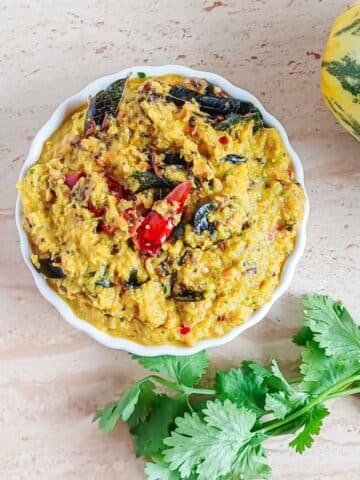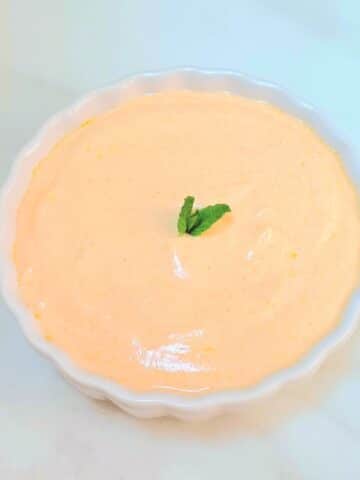Tomato mint chutney also termed pudina tomato pachadi is a flavourful condiment made with tomato, mint leaves and basic spices. It is commonly found in South Indian cuisine and goes well with idli, dosa and rice. This is a gluten free, vegan, no onion, no garlic recipe.

In most households, the tomato pudina pachadi recipe has many versions with a unique twist. This recipe is quick and easy, perfect for beginner cooks. It is a versatile dish that goes well with any meal of the day.
This south Indian tomato mint chutney doesn't require any fancy or gourmet ingredients that are difficult to find at the grocery store. To make this recipe, you'll just need a few basic Indian spices that are commonly used in Indian cooking and can be found in your spice pantry if you cook Indian meals or can be purchased from Indian or South Asian grocery stores.
Jump to:
Ingredients
For Chutney

- Herbs: Fresh mint and fresh coriander leaves
- Coconut: I've used frozen shredded coconut here.
- Spices and lentils: Cumin seeds, dried red chillies, tamarind, urad dal, jaggery, salt and chana dal.
- Vegetables: Green chillies, ginger, tamarind and tomato.
- Oil: I've used olive oil but feel free to use other cooking oil that you use for everyday cooking.
For Tadka

- Oil: Olive oil for tadka. But any cooking oil works.
- Spices and Lentils: Mustard seeds, cumin, red chillies, asafoetida, urad dal and curry leaves.
See the recipe card for quantities.
How to make tomato mint chutney?

Heat half a teaspoon oil in a pan over medium heat. Add chana dal, and urad dal and fry until they release the nutty aroma and start turning golden brown.
Add green chillies and red chillies. Sauté until the chillies release a pungent aroma.
Now add ginger and cumin seeds. Saute for a minute.
Transfer the fried lentils, ginger and lentils into a small bowl.

Now again heat half a teaspoon oil in the same pan over medium heat.
Add the fresh mint leaves (pudina) and cook for another 2-3 minutes until the mint leaves wilt.
Now add fresh coriander leaves and cook for a minute.
Transfer the herbs into a bowl and allow the mixture to cool down slightly.

Now heat 1 teaspoon oil in the same pan.
Add tomatoes, a pinch of salt, tamarind and cook for 4-5 minutes or until tomato turns soft and mushy.
Switch the heat off and let the mixture cool completely.

Meanwhile, transfer the lentil mixture to a blender or food processor. Blend it into a coarse mixture.

Now add cooked mint and coriander, coconut, cooked tomato mixture, jaggery and salt. Blend the mixture into a paste.
Once blended, transfer the chutney to a serving bowl.

To make tadka, heat oil in a small pan over medium heat.
Once the oil is hot, add mustard, cumin seeds, and urad dal and fry for a minute until mustard splatters.
Now add red chillies and asafoetida, then cook for a minute until red chillies release a pungent aroma.
Add curry leaves and stir well and switch the heat off.

Pour the tadka into the bowl of tomato pudina pachadi and stir well to combine.
Enjoy south Indian tomato mint chutney with dosas, idlis or as a side dish with rice.
Check out another variety coconut coriander chutney on the blog.
Substitutions and Variations
Coconut: Freshly grated or desiccated coconut could be used instead of frozen coconut for a creamy texture and a hint of sweetness.
Nuts and Seeds: To enhance the thickness and add a nutty taste, mix in roasted peanuts, cashews, or sesame seeds.
Tanginess: Tamarind could be substituted with tamarind pulp or dried mango powder (amchur).
Curry Leaves: I had to use dried curry leaves as fresh curry leaves were not available at the nearby grocery store. Fresh curry leaves elevate the taste and aroma of the chutney. So use fresh leaves if you have them.
Serving Suggestions
With South Indian Breakfast: Serve with dosa, idli, uttapam, or vada. It's a classic accompaniment that adds a burst of flavour to these dishes.
As a Spread: Use it as a spread for sandwiches, wraps, or rolls. It adds a fabulous flavour to wraps or sandwiches.
With Rice: Serve chutney with steamed rice and a dollop of ghee for a fast and delicious meal on busy days. It can be enjoyed as a side dish with rice and dosakaya pappu as well.
Accompaniment to Snacks: Serve it alongside snacks such as vegetable pakoras, samosas, bonda or bajjis. It works well as a dipping sauce, adding a spicy and tangy flavour to the snacks.
As a Condiment: Use it as a condiment to enhance the taste of your meals. It pairs well with chapati or paratha.

Storage
Fridge: This chutney can be stored in an airtight container in the refrigerator for 3-4 days.
Tips and Tricks
Tomatoes: Use ripe and flavorful tomatoes for the best taste. If they’re too tangy, you can balance it by adding extra jaggery while grinding.
Mint Leaves: Use fresh mint leaves for a vibrant flavour. Wash the leaves thoroughly before using them in the chutney to get rid of any dirt or impurities.
Adjust Spice Levels: Adjust the number of chilies to match your spice preference. Experiment with a combination of spicy and mild chilies for a nuanced heat.
FAQ
Mature or old mint leaves often develop a bitter taste. Always use fresh, young mint leaves for the best flavour.
Overcooking mint leaves can also cause a bitter taste. They should only be lightly cooked or wilted to preserve their fresh flavour.
Using the tough and overly mature stems and stalks can add bitterness, so it's best to avoid them. It's better to use young mint leaves and discard the tougher stems and stalks. This can help ensure a fresher and more vibrant mint flavour without the risk of unwanted bitterness.
Yes, you can freeze pudina tomato chutney for a longer shelf life and to preserve the flavours. You can freeze it for up to 3 months.
Allow the chutney to cool completely after grinding before putting it in the freezer.
Divide the chutney into your desired portions according to your usage. This way, you can thaw only the amount you need without thawing the entire batch repeatedly.
Place each portion in an airtight, freezer-safe container or zip-top freezer bag. Ensure you leave some space at the top of the container or bag.
Place the portioned chutney in the freezer. Lay flat if using freezer bags for easier storage and to save space.
Once you're prepared to use the chutney, refrigerate a portion overnight to thaw. Another option is to use the microwave's defrost setting to thaw it.
KEEP IN TOUCH
Do let me know if you try this south Indian tomato mint chutney recipe. If you like this recipe kindly consider rating it using stars in the comment section or on the recipe card to help more people find this recipe online. You can stay up to date by following me on Facebook, Pinterest, Instagram or subscribing to my Youtube channel. Or why not subscribe to my blog and get simple recipes straight to your inbox?
📖 Recipe Card
Tomato Mint Chutney
Equipment
- 1 Mixer Grinder
- 1 Spoon
- 2 bowls
Ingredients
1 Cup = 250ml ; 1 Tablespoon = 15ml ; 1 Teaspoon = 5ml
For Chutney
- 1 Teaspoon Oil
- 1 Tablespoon Chana Dal
- 1 Tablespoon Urad Dal
- 5 Green Chillies adjust to your preffered spice level
- 5 Dried Red Chillies adjust to your preferred spice level
- ½ Tablespoon Cumin
- ½ inch Fresh Ginger Root washed and peeled
- ½ Teaspoon Oil
- 40 gms (or) 1.5 Cups Fresh Mint Leaves washed and stems discarded
- 10 gms (or) ⅓ Cup Fresh Coriander Leaves washed
- 1 Teaspoon Oil
- 160 gms (or) 1 big Tomato chopped
- a pinch Salt
- 3 gms Tamarind
- 2 Tablespoons Frozen Grated Coconut thawed
- ½ Teaspoon Jaggery
- Salt as required
For Tadka
- ½ Tablespoon Oil
- ½ Teaspoon Mutard Seeds
- ½ Teaspoon Cumin Seeds
- ½ Teaspoon Urad Dal
- handful Curry Leaves washed
- 2 Dried Red Chillies each broken into 2-3 pieces
- big pinch Asafoetida
Instructions
For Chutney
- Heat ½ teaspoon oil in a pan over medium heat. Add chana dal, urad dal and fry until they release the nutty aroma and start turning golden brown.1 Teaspoon Oil, 1 Tablespoon Chana Dal, 1 Tablespoon Urad Dal
- Add green chillies and dried red chillies. Sauté until the chillies release pungent aroma.5 Green Chillies, 5 Dried Red Chillies
- Now add ginger and cumin seeds. Saute for a minute.½ Tablespoon Cumin, ½ inch Fresh Ginger Root
- Transfer the fried lentils, ginger and lentils into a small bowl.
- Now heat ½ teaspoon oil in the same pan over medium heat.½ Teaspoon Oil
- Add the fresh mint leaves (pudina) and cook for another 2-3 minutes until the mint leaves wilt.40 gms (or) 1.5 Cups Fresh Mint Leaves
- Now add fresh coriander leaves and cook for a minute.10 gms (or) ⅓ Cup Fresh Coriander Leaves
- Transfer the herbs into a bowl and allow the mixture to cool down slightly.
- Now heat 1 teaspoon oil in the same pan.1 Teaspoon Oil
- Add tomatoes, a pinch of salt, tamarind and cook for 4-5 minutes or until tomato turn soft and mushy.160 gms (or) 1 big Tomato, a pinch Salt, 3 gms Tamarind
- Switch the heat off and let the mixture cool completely.
- Meanwhile, transfer the lentil mixture to a blender or food processor. Blend it into a coarse mixture.
- No add cooked mint and coriander, coconut, cooked tomato mixture, jaggery and salt. Blend the mixture into a paste.2 Tablespoons Frozen Grated Coconut, ½ Teaspoon Jaggery, Salt
- Once blended, transfer the chutney to a serving bowl.
- To make tadka, heat oil in the same pan over medium heat.½ Tablespoon Oil
- Once the oil is hot, add mustard, cumin seeds, and urad dal and fry for a minute until mustard splatters.½ Teaspoon Mutard Seeds, ½ Teaspoon Cumin Seeds, ½ Teaspoon Urad Dal
- Now add red chillies and asafoetida, then cook for a minute until red chillies release a pungent aroma.2 Dried Red Chillies, big pinch Asafoetida
- Add curry leaves and stir well and switch the heat off.handful Curry Leaves
- Pour the tadka into the bowl of tomato pudina pachadi and stir well to combine.
Notes
Nutrition
Related
Looking for other chutney recipes like this? Try these:
More Mint Recipes

Welcome to Flavours Treat. I share vegetarian recipes made with wholesome, mostly fresh ingredients. Every recipe has easy-to-follow instructions with process shots (detailed step-wise pictures), a short video and lots of tips to help your cooking journey. Read more















Leave a Reply